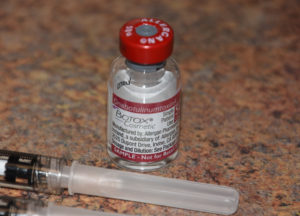Injectable neuromuscular modulators (Botox and Dysport)are the single most effective non-surgical treatment of the face for wrinkle reduction and an overall anti-aging effect. They are fairly simple to inject and the large numbers of patients who are successfully and happily treated, by practitioners of a wide variety of educational backgrounds, is a testament to its effectiveness and excellent margin of safety.

The most dreaded and well known complication of injectable neuromuscular facial treatments is upper eyelid drooping, known as ptosis. This occurs when the toxin diffuses or migrates from an injection site in or around the eyebrows down into the upper eyelid. The position of the upper eyelid margin drops down, covering some portion of the iris. This is easily seen by all and no patient wants to walk around for months with an eyelid at ‘half-mast’. This results from injecting too close to the eyebrow or putting in large volume in an injection site near the eyebrow. Fortunately, eyelid ptosis is very uncommon as there is no known reversal or antidote to this problem other than letting it wear off.
One of the more frequently seen adverse effects is an unusual or unnatural looking forehead movements. When the area between the eyebrows (glabella) is treated, those pesky vertical lines and furrows will go away but the rest of the forehead is unaffected. For those with very active forehead movements, this can result in a central zone of paralysis amidst a sea of moving forehead areas. This may also make the eyebrows lift up in its mid- to lateral parts but not in the brow area closest to the nose. (known as a ‘Spock’ brow) These abnormal forehead movements can be easily managed by the judicious placement of injections in other areas of the forehead to soften those movements and create a less active but more symmetric movement of the forehead and brows.
The last adverse forehead effect is an undesired lowering of the eyebrows, also known as ptosis. When too many injections are done above the brow and across the forehead, the eyebrow may feel heavy and actually drop a little bit. The arch of the eyebrow may change as well. In some cases, placing injections high up along the scalp line may cause the eyebrow to raise although this is not always successful.
Botox and Dysport have a very profound reducing effect on facial muscle movements where they are injected. But forehead movements, eyebrow and eyelid positions all may be adversely effected by these injections and sometimes it is possible to have too much of a good thing. In somes cases, additional ‘balancing’ injections can be done to counteract how the muscle movements have been affected. When in doubt as to whether more injections can be effective, I prefer in my Indianapolis plastic surgery practice to first use a local anesthetic that lasts for 24 hours or so and see if the patient finds it helpful…before proceeding with the longer acting injections. Upper eyelid ptosis, however, is largely irreversible and must await the tincture of time.
Barry L. Eppley, M.D., D.M.D.
Indianapolis, Indiana



